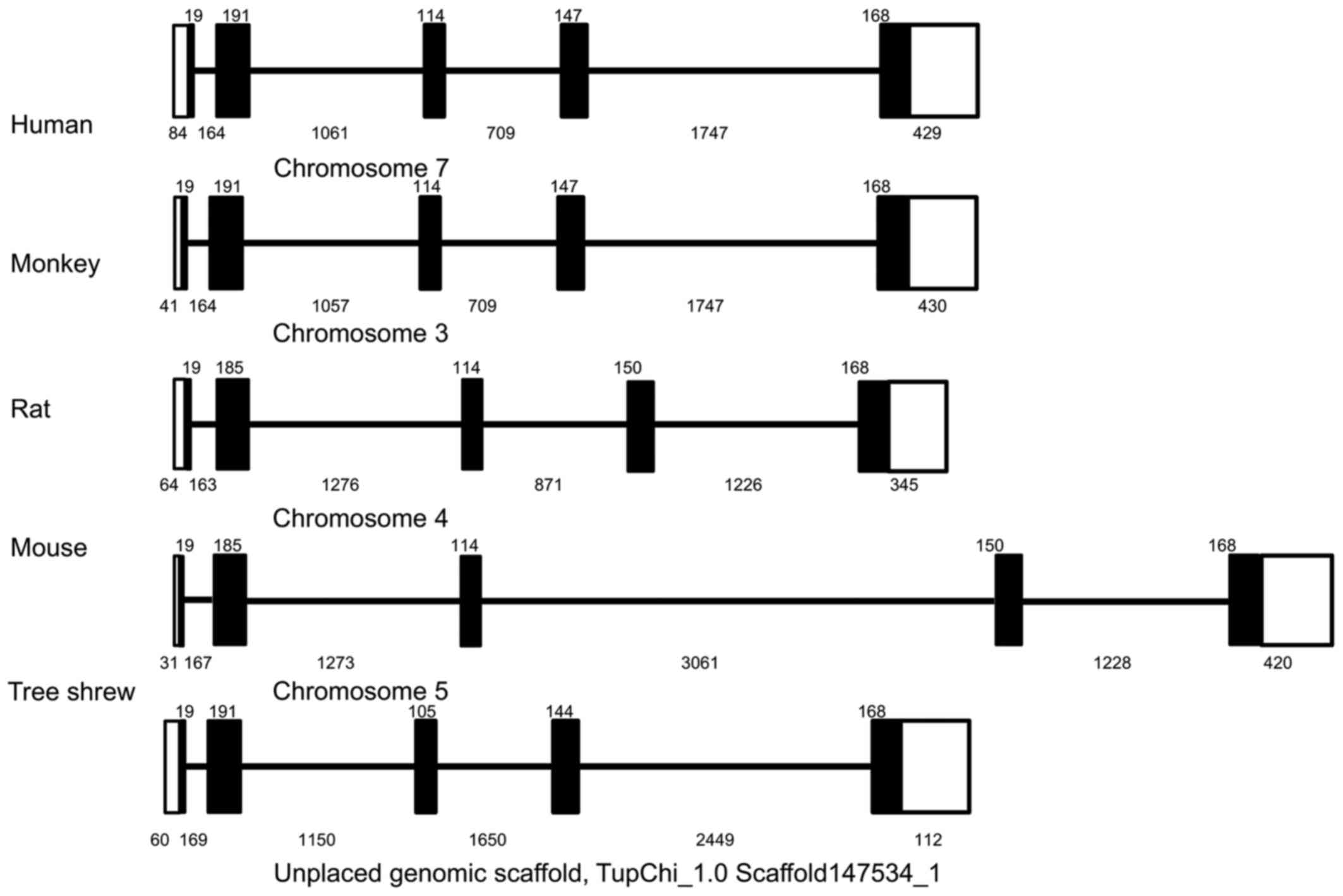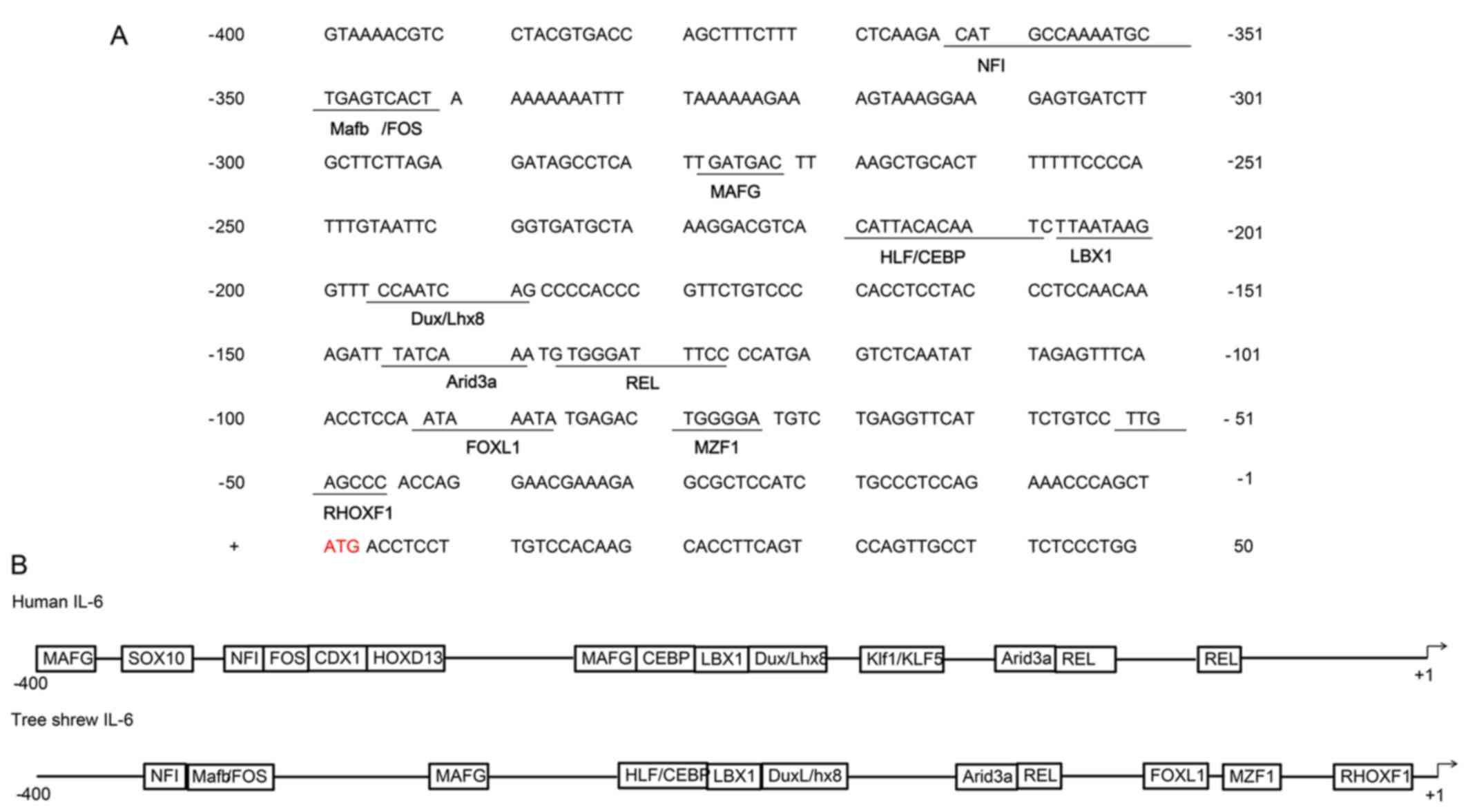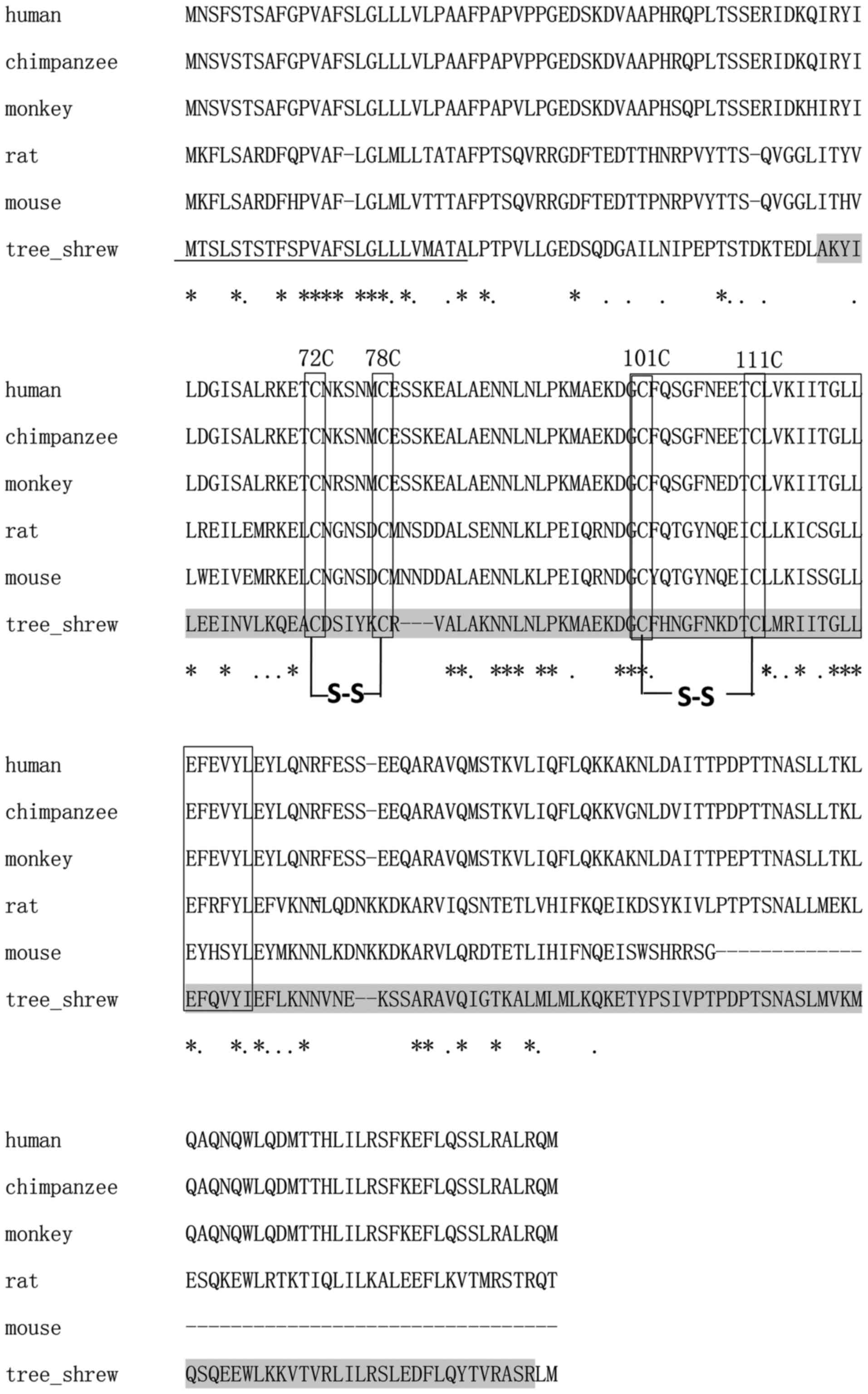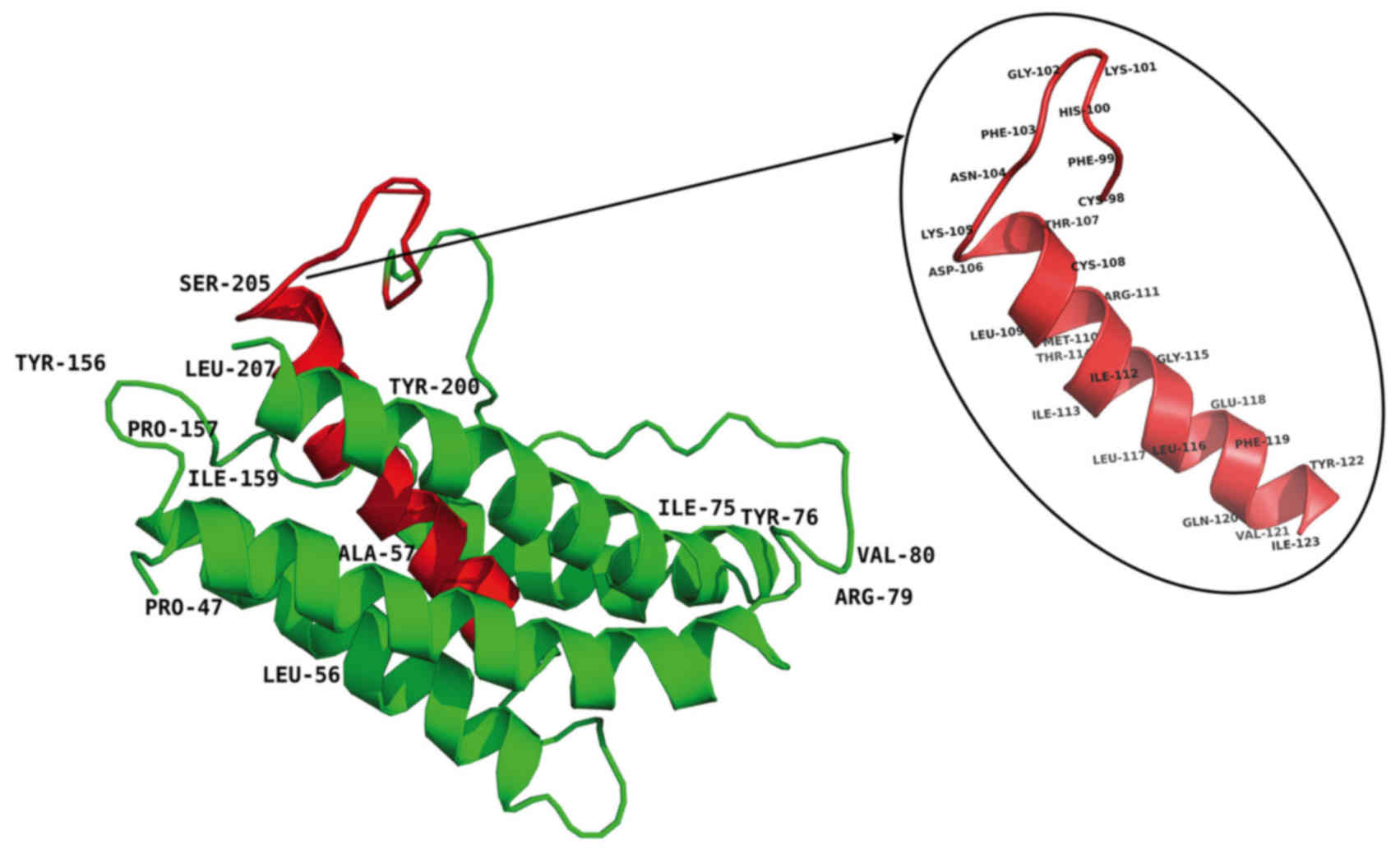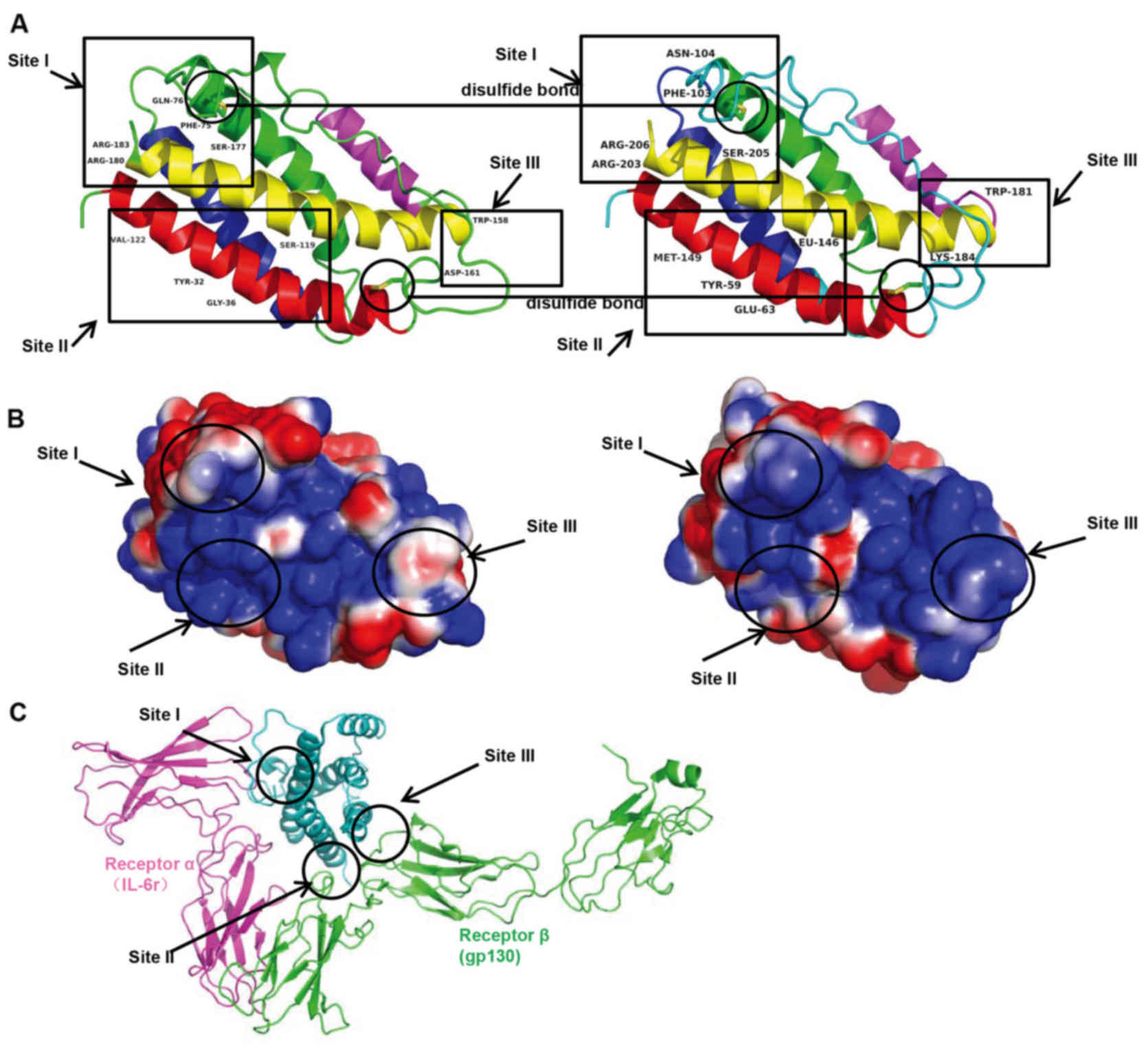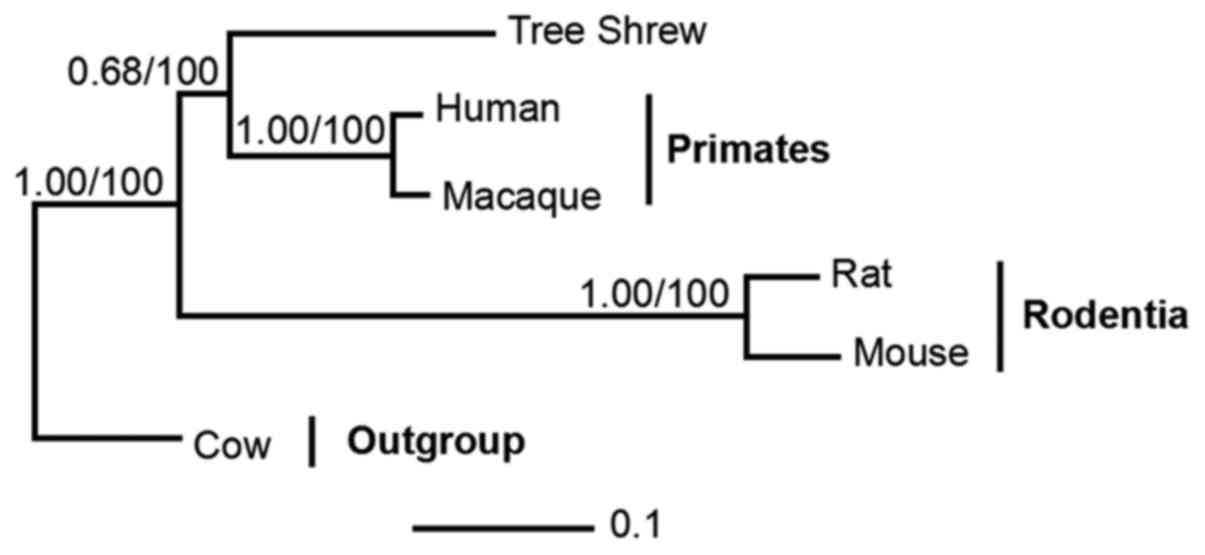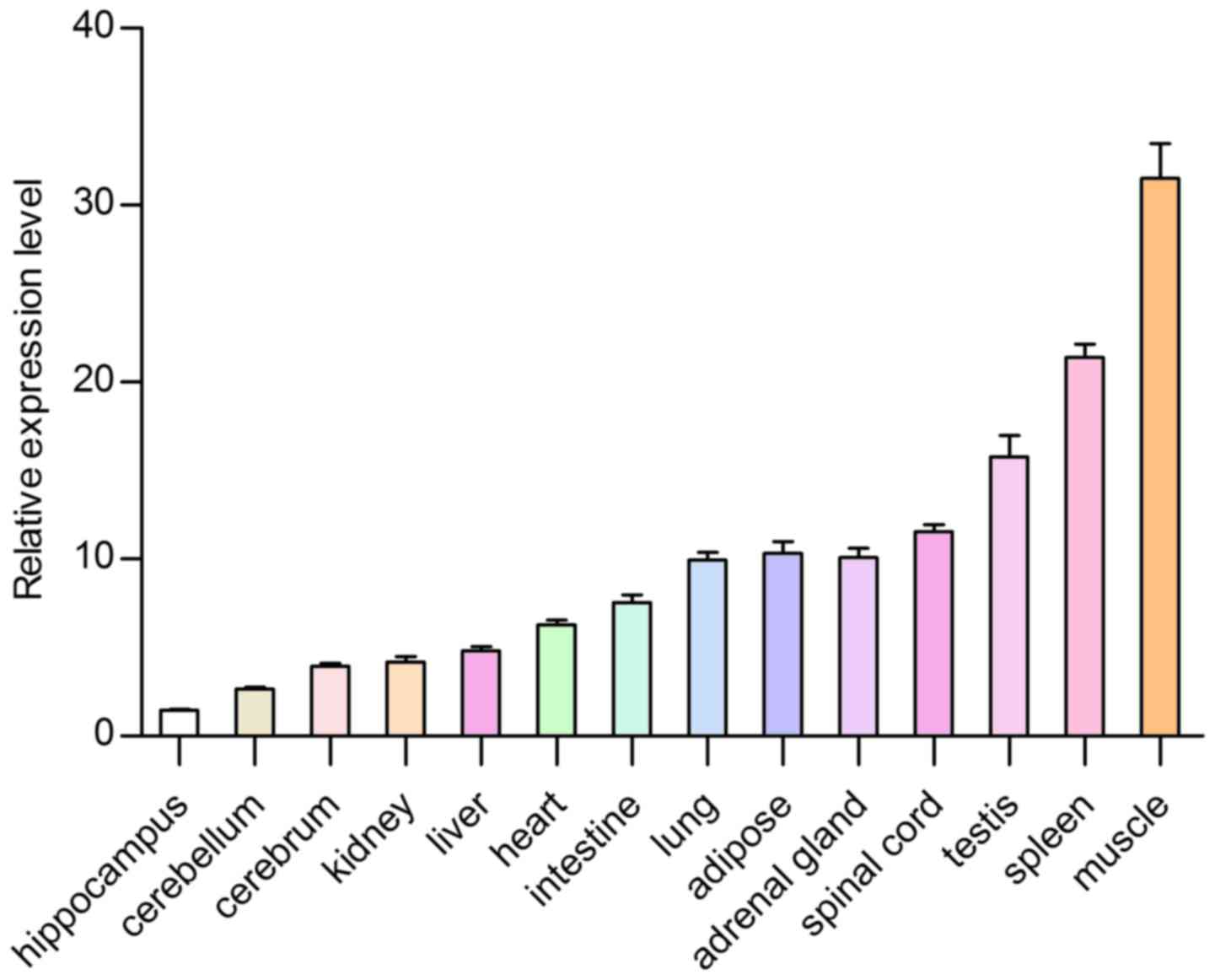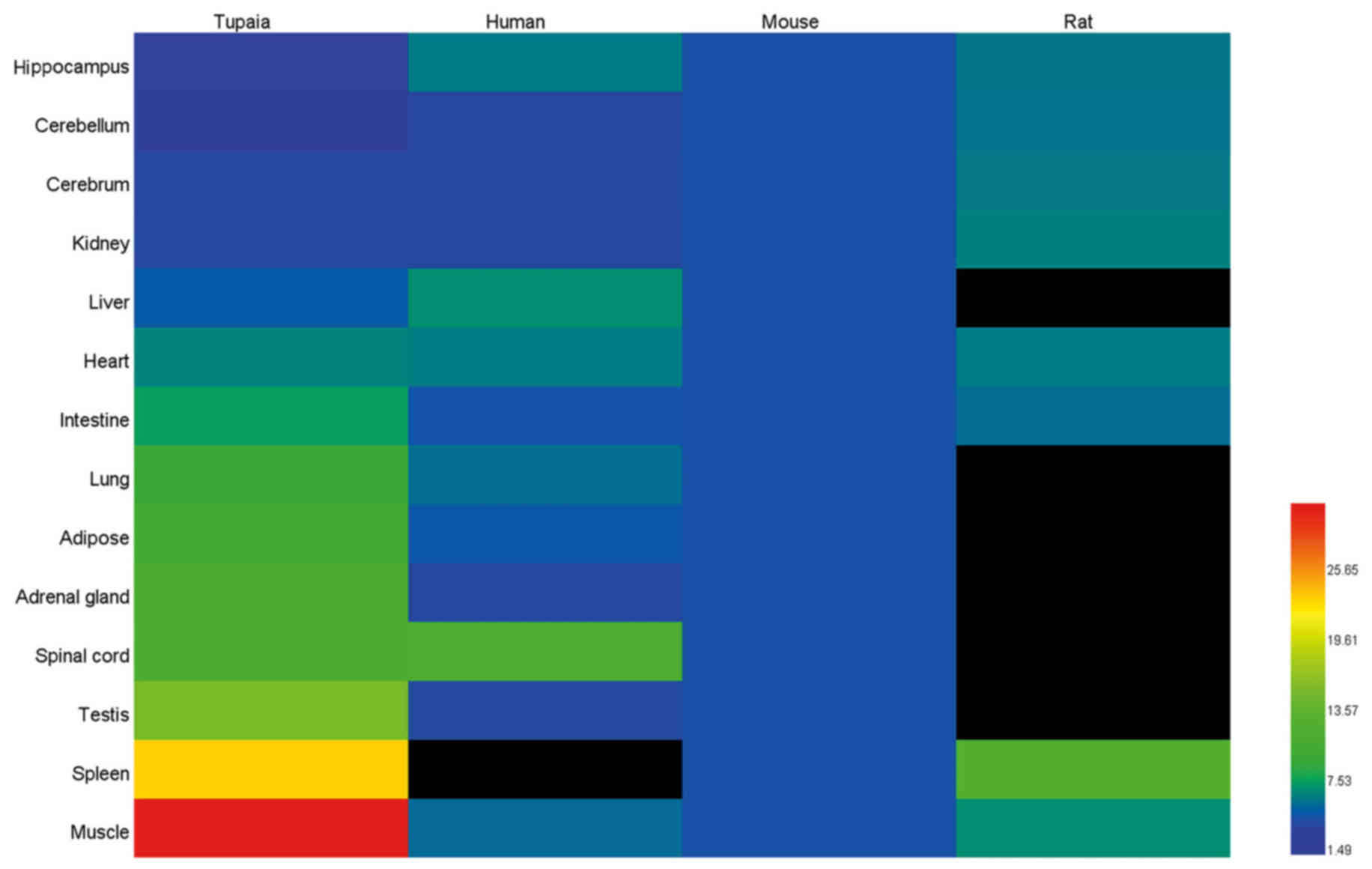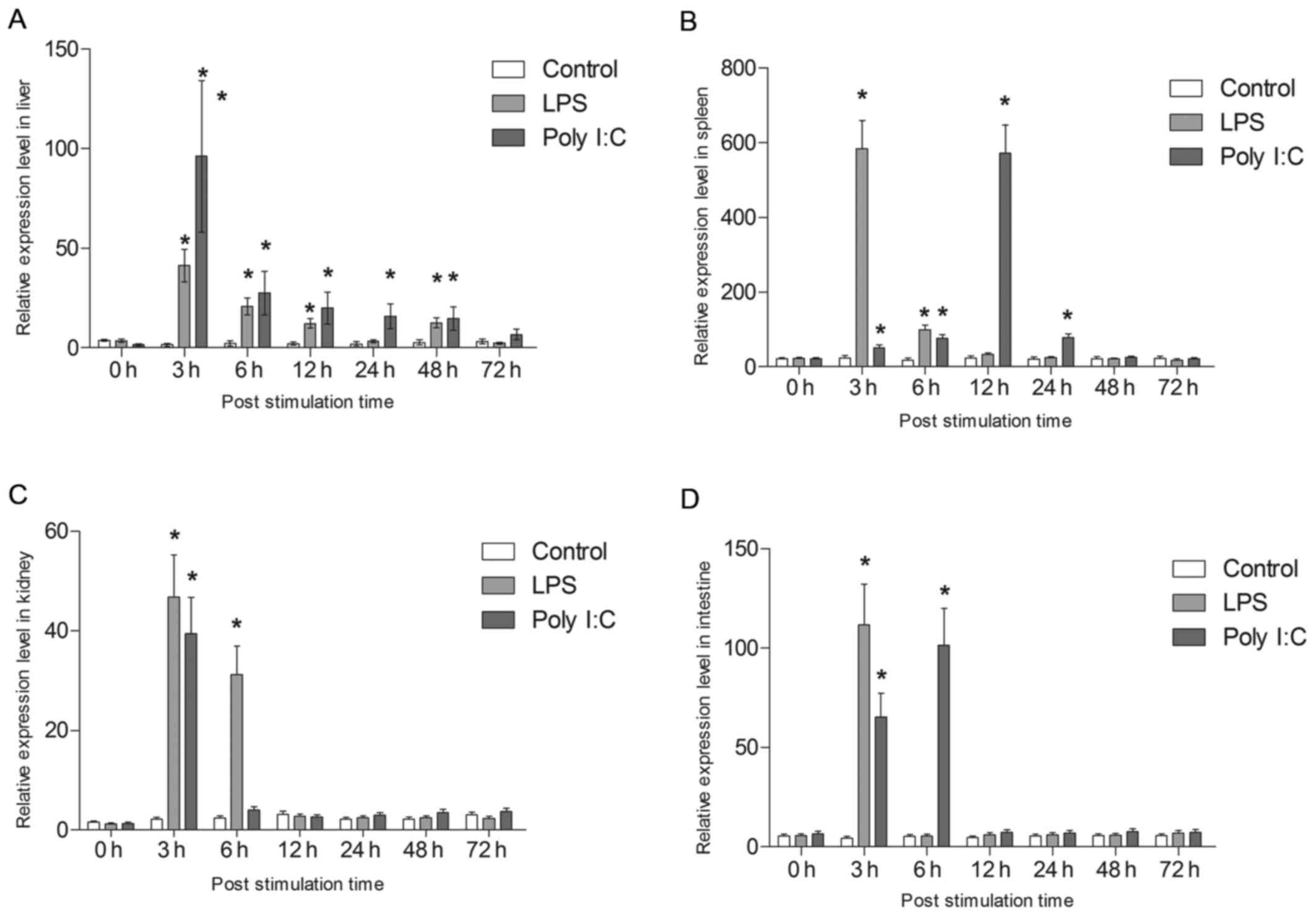|
1
|
Yang EB, Cao J, Su JJ and Chow P: The tree
shrews: Useful animal models for the viral hepatitis and
hepatocellular carcinoma. Hepatogastroenterology. 52:613–616.
2005.PubMed/NCBI
|
|
2
|
Fuchs E: Social stress in tree shrews as
an animal model of depression: An example of a behavioral model of
a CNS disorder. CNS. 10:182–190. 2005.
|
|
3
|
Norton TT and Siegwart JT Jr: Light
levels, refractive development, and myopia - a speculative review.
Exp Eye Res. 114:48–57. 2013. View Article : Google Scholar : PubMed/NCBI
|
|
4
|
Guo L, Frost MR, Siegwart JT Jr and Norton
TT: Scleral gene expression during recovery from myopia compared
with expression during myopia development in tree shrew. Mol Vis.
20:1643–1659. 2014.PubMed/NCBI
|
|
5
|
Ye L, He M, Huang Y, Zhao G, Lei Y, Zhou Y
and Chen X: Tree shrew as a new animal model for the study of lung
cancer. Oncol Lett. 11:2091–2095. 2016.PubMed/NCBI
|
|
6
|
Lin N, Xiong LL, Zhang RP, Zheng H, Wang
L, Qian ZY, Zhang P, Chen ZW, Gao FB and Wang TH: Injection of
Aβ1-40 into hippocampus induced cognitive lesion associated with
neuronal apoptosis and multiple gene expressions in the tree shrew.
Apoptosis. 21:621–640. 2016. View Article : Google Scholar : PubMed/NCBI
|
|
7
|
Hunter CA and Jones SA: IL-6 as a keystone
cytokine in health and disease. Nat Immunol. 16:448–457. 2015.
View Article : Google Scholar : PubMed/NCBI
|
|
8
|
Lohrengel B, Lu M and Roggendorf M:
Molecular cloning of the woodchuck cytokines: TNF-alpha, IFN-gamma,
and IL-6. Immunogenetics. 47:332–335. 1998. View Article : Google Scholar : PubMed/NCBI
|
|
9
|
Nagarajan G, Swami SK, Ghorui SK, Pathak
KM, Singh RK and Patil NV: Cloning and phylogenetic analysis of
interleukin-6 (IL-6) and tumor necrosis factor-α (TNF-α) from
Indian dromedaries (Camelus dromedarius). Comp Immunol Microbiol
Infect Dis. 34:291–298. 2011. View Article : Google Scholar : PubMed/NCBI
|
|
10
|
Takakura H, Mori Y and Tatsumi M:
Molecular cloning of caprine IL-6 cDNA and its expression in insect
cells. Int Arch Allergy Immunol. 113:409–416. 1997. View Article : Google Scholar : PubMed/NCBI
|
|
11
|
Zhu Q, Li C, Yu ZX, Zou PF, Meng QX and
Yao CL: Molecular and immune response characterizations of IL-6 in
large yellow croaker (Larimichthys crocea). Fish Shellfish Immunol.
50:263–273. 2016. View Article : Google Scholar : PubMed/NCBI
|
|
12
|
Iliev DB, Castellana B, Mackenzie S,
Planas JV and Goetz FW: Cloning and expression analysis of an IL-6
homolog in rainbow trout (Oncorhynchus mykiss). Mol Immunol.
44:1803–1807. 2007. View Article : Google Scholar
|
|
13
|
Yu D, Wu Y, Xu L, Fan Y, Peng L, Xu M and
Yao YG: Identification and characterization of toll-like receptors
(TLRs) in the Chinese tree shrew (Tupaia belangeri chinensis). Dev
Comp Immunol. 60:127–138. 2016. View Article : Google Scholar : PubMed/NCBI
|
|
14
|
Yu D, Xu L, Liu XH, Fan Y, Lü LB and Yao
YG: Diverse interleukin-7 mRNA transcripts in Chinese tree shrew
(Tupaia belangeri chinensis). PLoS One. 9:e998592014. View Article : Google Scholar : PubMed/NCBI
|
|
15
|
Zheng Y, Yun C, Wang Q, Smith WW and Leng
J: Identification of the full-length β-actin sequence and
expression profiles in the tree shrew (Tupaia belangeri). Int J Mol
Med. 35:519–524. 2015. View Article : Google Scholar
|
|
16
|
Fan Y, Yu D and Yao YG: Tree shrew
database (TreeshrewDB): A genomic knowledge base for the Chinese
tree shrew. Sci Rep. 4:71452014. View Article : Google Scholar : PubMed/NCBI
|
|
17
|
Jain R, Gomer RH and Murtagh JJ Jr:
Increasing specificity from the PCR-RACE technique. Biotechniques.
12:58–59. 1992.PubMed/NCBI
|
|
18
|
Edgar RC: MUSCLE: Multiple sequence
alignment with high accuracy and high throughput. Nucleic Acids
Res. 32:1792–1797. 2004. View Article : Google Scholar : PubMed/NCBI
|
|
19
|
Ronquist F and Huelsenbeck JP: MrBayes 3:
Bayesian phylogenetic inference under mixed models. Bioinformatics.
19:1572–1574. 2003. View Article : Google Scholar : PubMed/NCBI
|
|
20
|
Meyer X, Chopard B and Salamin N:
Accelerating Bayesian inference for evolutionary biology models.
Bioinformatics. 33:669–676. 2017.
|
|
21
|
Stamatakis A, Ludwig T and Meier H:
RAxML-III: A fast program for maximum likelihood-based inference of
large phylogenetic trees. Bioinformatics. 21:456–463. 2005.
View Article : Google Scholar
|
|
22
|
Remans T, Smeets K, Opdenakker K,
Mathijsen D, Vangronsveld J and Cuypers A: Normalisation of
real-time RT-PCR gene expression measurements in Arabidopsis
thaliana exposed to increased metal concentrations. Planta.
227:1343–1349. 2008. View Article : Google Scholar : PubMed/NCBI
|
|
23
|
Siemetzki U, Ashok MS, Briese T and Lipkin
WI: Identification of RNA instability elements in Borna disease
virus. Virus Res. 144:27–34. 2009. View Article : Google Scholar : PubMed/NCBI
|
|
24
|
Fu X, Ding Z, Fan J, Wang H, Zhou F, Cui
L, Boxiang C, Wang W and Liu H: Characterization, promoter analysis
and expression of the interleukin-6 gene in blunt snout bream,
Megalobrama amblycephala. Fish Physiol Biochem. 42:1527–1540. 2016.
View Article : Google Scholar : PubMed/NCBI
|
|
25
|
Lindblad-Toh K, Garber M, Zuk O, Lin MF,
Parker BJ, Washietl S, Kheradpour P, Ernst J, Jordan G, Mauceli E,
et al Broad Institute Sequencing Platform and Whole Genome Assembly
Team; Baylor College of Medicine Human Genome Sequencing Center
Sequencing Team; Genome Institute at Washington University: A
high-resolution map of human evolutionary constraint using 29
mammals. Nature. 478:476–482. 2011. View Article : Google Scholar : PubMed/NCBI
|
|
26
|
Zhou X, Sun F, Xu S, Yang G and Li M: The
position of tree shrews in the mammalian tree: Comparing multi-gene
analyses with phylogenomic results leaves monophyly of Euarchonta
doubtful. Integr Zool. 10:186–198. 2015. View Article : Google Scholar
|
|
27
|
Boulanger MJ, Chow DC, Brevnova EE and
Garcia KC: Hexameric structure and assembly of the
interleukin-6/IL-6 alpha-receptor/gp130 complex. Science.
300:2101–2104. 2003. View Article : Google Scholar : PubMed/NCBI
|
|
28
|
Ikeda SI, Tamura Y, Kakehi S, Sanada H,
Kawamori R and Watada H: Exercise-induced increase in IL-6 level
enhances GLUT4 expression and insulin sensitivity in mouse skeletal
muscle. Biochem Biophys Res Commun. 473:947–952. 2016. View Article : Google Scholar : PubMed/NCBI
|
|
29
|
Ono T, Maekawa K, Watanabe S, Oka H and
Kuboki T: Muscle contraction accelerates IL-6 mRNA expression in
the rat masseter muscle. Arch Oral Biol. 52:479–486. 2007.
View Article : Google Scholar : PubMed/NCBI
|
|
30
|
Gleeson M: Interleukins and exercise. J
Physiol. 529:12000. View Article : Google Scholar : PubMed/NCBI
|
|
31
|
Hacham M, Cristal N, White RM, Segal S and
Apte RN: Complementary organ expression of IL-1 vs. IL-6 and CSF-1
activities in normal and LPS-injected mice. Cytokine. 8:21–31.
1996. View Article : Google Scholar : PubMed/NCBI
|
|
32
|
Szot P, Franklin A, Figlewicz DP, Beuca
TP, Bullock K, Hansen K, Banks WA, Raskind MA and Peskind ER:
Multiple lipopolysaccharide (LPS) injections alter interleukin 6
(IL-6), IL-7, IL-10 and IL-6 and IL-7 receptor mRNA in CNS and
spleen. Neuroscience. 355:9–21. 2017. View Article : Google Scholar : PubMed/NCBI
|
|
33
|
Jeong YH, Park JS, Kim DH, Kang JL and Kim
HS: Anti-inflammatory mechanism of lonchocarpine in LPS- or
poly(I:C)-induced neuroinflammation. Pharmacol Res. 119:431–442.
2017. View Article : Google Scholar : PubMed/NCBI
|
|
34
|
Kimura K, Orita T, Nomi N, Fujitsu Y,
Nishida T and Sonoda KH: Identification of common secreted factors
in human corneal fibroblasts exposed to LPS, poly(I:C), or zymosan.
Exp Eye Res. 96:157–162. 2012. View Article : Google Scholar
|




